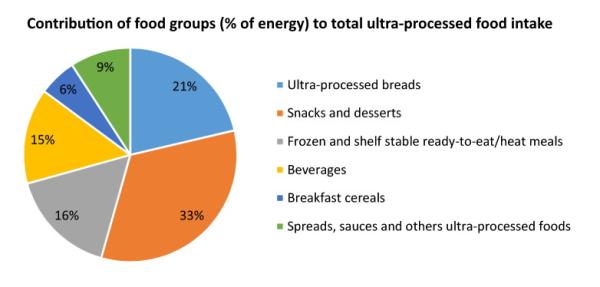In this month's newsletter, we examine the relationship between ultra-processed foods and endocrine disrupting chemicals and explore how they may contribute to obesity.
Ultra-processed Foods and Obesity
NOVA – a food classification that categorizes foods according to the extent and purpose of processing – defines ultra-processed foods (UPFs) as “formulations made mostly or entirely from substances derived from foods and additives.” Examples of UPFs include soft drinks, sweet or savory packaged snacks and baked goods, pre-prepared and “instant” dishes, and reconstituted meat products. These foods contain ingredients processed industrially – such as high-fructose corn syrup, hydrogenated oils, hydrolyzed proteins, and cosmetic additives. UPFs make up over half (58.5%) of the total dietary energy consumed in the United States; in 2018 the estimated percentage of total energy consumed from UPFs among US youths aged 2-19 years was approximately 67.0%.
The upward trends in UPF sales and consumption does not bode well for the obesity epidemic. Among adults, diets high in ultra-processed foods are associated with excess calorie intake and weight gain. A large cohort study of participants aged 40-69 years found that higher UPF consumption is associated with a ≥ 5% increase in BMI from baseline to follow-up after 5.8 years and a significantly higher risk of developing overweight and obesity. Globally, increases in ultra-processed food and drink volume sales per capita are positively associated with mean population BMI. Findings from a recent cohort study suggest that higher consumption of UPFs in childhood is associated with more rapid increase of weight, waist circumference, and BMI into adolescence and early adulthood.
Source: Rauber et al., 2020
Endocrine Disrupting Chemicals and Obesity
An endocrine-disrupting chemical, or EDC, is defined as “an exogenous substance or mixture that alters function(s) of the endocrine system and consequently causes adverse health effects” to an organism. Substantial literature suggests that two classes of EDCs used in the production of plastic products – phthalates and bisphenols – penetrate food and the environment. Nearly 100% of the US population is exposed to phthalates on a daily basis, and bisphenol metabolites were found in over 90% of participants in a nationally-representative sample of individuals ≥6 years of age. EDCs have been associated with weight gain, stimulation of fat cells, and predisposition to metabolic disorders such as type 2 diabetes. A large body of cross-sectional research has demonstrated a relationship between BPA exposure and increased risk of diabetes, general/abdominal obesity, and hypertension. Systematic reviews have also linked phthalate exposure to diabetes and insulin resistance.
Endocrine Disrupting Chemicals in Ultra-processed Foods
UPFs are often packaged in materials that are a source of EDCs. For example, bisphenol A (BPA) is found in food packaging such as water bottles and coatings on food and beverage cans. Phthalates are also found in food packaging such as cling film, and they are soluble in oil and are therefore commonly found in foods high in fat. A preliminary analysis of items from U.S. fast food chains found detectable levels of phthalates and other plasticizers in food items and food handling gloves, which may be a source of contamination. Because UPFs are generally packaged, and food packaging often contains EDCs, UPFs are likely to contribute to concentrations of EDCs that people ingest.
The increased production and consumption of UPFs, combined with the increased production and use of various EDC-containing products like food packaging, may have a synergistic effect that further contributes to the development and persistence of obesity globally. While further research is needed to better understand the effects of this synergy on obesity, these observations demonstrate yet another reason to eat less processed foods.



